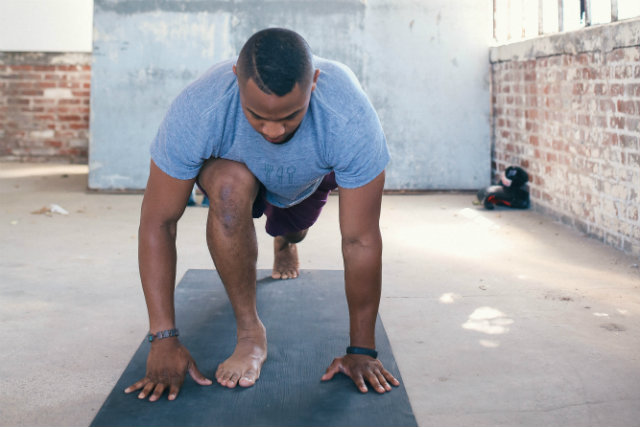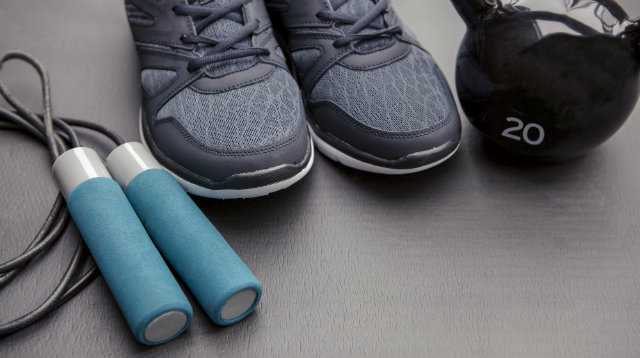The potential benefits of workplace wellness programs are well-documented. Offering a company exercise space is a great way to bring those benefits to bear, boosting employee morale and decreasing absenteeism — but that doesn’t mean you have to blow next year’s entire budget on expensive exercise equipment.
No matter the size of your company or your budget, setting up an office gym for your employees is possible. Keep reading to learn the easy, inexpensive ways you can safely and effectively equip a company exercise space.
 The Bodyweight Approach
The Bodyweight Approach
Your employees already come equipped with the most versatile exercise equipment ever created: their bodies. Bodyweight exercises like push-ups, pull-ups, and planks are highly effective and don’t cost a dime, but adding a little equipment into the mix makes bodyweight workouts even more fun and effective.
Floor Mats
This inexpensive piece of equipment makes it much more comfortable for your employees to assume some of the interesting positions that come with bodyweight exercises — think push-up or plank position, or lying on their backs for crunches. Yoga mats are perfect for this application.
Exercise Balls
Sometimes used as entertaining office chairs, this piece of equipment opens the door to doing exercise ball crunches, which a study by the American Council on Exercise identified as one of the best ab exercises. You can also use them to for stretching or to add instability to almost any workout. For example, if you’re working on push-ups, you can make the exercise more difficult by balancing your hands on the ball as you do them.
The VKR Station
Pull-ups, dips, and knee raises are all great bodyweight exercises, but they are hard to do without the proper equipment. The VKR, or vertical knee raise station, sometimes also called a captain’s chair, has protruding bars that make it possible to do all these exercises. Best of all, the VKR station has no moving parts, so little can go wrong or break down.
Suspension Trainers
The gold standard in bodyweight training is the suspension trainer, a set of handles that dangle from the wall or ceiling support like gymnast’s rings. You can use a suspension trainer to add extra core-busting instability and difficulty to all of your favorite exercises, and to work muscles — especially your back — that are difficult to target without this type of equipment.
 Strength Training Equipment
Strength Training Equipment
If your office gym or exercise space is big enough to accommodate some weightlifting equipment, you have three options: machines, dumbbells, or barbells. Dumbbells are by far the best choice for a small gym on a budget. They’re more versatile, less expensive, don’t have any moving parts to go wrong, and take up less space than the competition. If space is truly limited, you can purchase adjustable dumbbells that help you pack a full set of free weights into the space it would take to store only a couple standard dumbbells.
Cardio Equipment
Treadmills and elliptical trainers are the default cardio equipment for most small gyms, but don’t assume you’re locked in just yet. There are several other types of cardio equipment that take up less space, cost a lot less, or both. Here are the pros and cons of the some of the most common types of cardio equipment you can buy:
- Stationary Bikes: For most of your employees, riding a bike will be almost as familiar as the motion of walking on a treadmill or elliptical trainer. Exercise bikes also take up less space and generally cost less than a treadmill or elliptical of similar quality.
- Stationary Rowers: Stationary rowing machines are often the least-expensive cardio option. When in use, their footprint is a little bigger than most other exercise equipment, but they can usually be stored upright and out of the way. They also require a little extra know-how to use correctly — but once you get the knack of it, rowers provide a great full-body workout along with cardio benefits.
- Stair Steppers: Once all the rage, these upright cardio machines are still great if you’re working with limited floor space in your office gym — but there’s not much else to recommend about them. Any other type of exercise machine will give you greater range of motion and keep your employees more entertained and engaged.
- Calisthenics: All of the aforementioned types of cardio equipment can get pricey, and they have moving parts that must be maintained for the safety of your employees. If you’re on a severe budget, you can at least get the cardio section of your company gym up and running with jump ropes, then upgrade it later — or provide instructional posters for full-body calisthenics, like burpees and mountain climbers.
 Where to Splurge in Your Office Gym
Where to Splurge in Your Office Gym
Most of the fitness equipment we’ve already mentioned is inexpensive and completely functional — but there are a few places where you truly get what you pay for. If you or your managers have a little extra money to spend, put it toward anything with moving parts, because those parts and their linkages are where you’re most likely to see problems. That includes any weight-training machines and all mechanized cardio equipment.
Once that’s taken care of, the next budget priority should be any equipment that supports your body weight. In most cases that is predominantly weight-training or cardio machines, but it can also mean pull-up, dip and vertical knee raise stations, stretching racks, and the like.
Here’s one last issue that definitely deserves some of your hard-earned money: employee education. That could take the shape of group fitness classes, one-on-one coaching with a personal trainer, or group orientations when the office gym equipment is first installed. No matter what sort of fitness equipment you provide, your employees need to know how to use it safely. This is also a great chance to educate your team about the benefits of workplace wellness, along with any other incentives you might offer to get them working out.
Flexibility and Core Training
So far, our equipment priorities have been cardiovascular fitness and strength training — the two best-known aspects of fitness. But there a couple other aspects of fitness that often go unappreciated: flexibility and core training.
The good news is that flexibility requires little equipment: a wall chart, complimentary app, or short trainer education session is all your employees need to make it happen, along with regular access to the exercise space and floor mats.
Core training takes a little more know-how, if only because doing it wrong carries the risk of injury. If you hire a trainer to educate your employees, ask him or her to make it a point to cover the principles of safe core strengthening and teach some basic exercises.
 Finding Great Office Gym Equipment on a Budget
Finding Great Office Gym Equipment on a Budget
Now that you know what kind of workout equipment to put in your office gym and what’s worth splurging on, you have one more hurdle to overcome: actually finding that equipment at a good price. Happily, there are many places you can look.
- If having a manufacturer warranty or support is important to you, getting refurbished equipment straight from the manufacturer is one of the best ways to get more bang for your buck.
- Buying used (but not refurbished) equipment from a dealer may not come with the same warranty or support, but it’s another great way to save money because you can get heavy-duty commercial equipment for the price of lesser “home user” equipment.
- You can find great online deals on classified ad sites like Craigslist, where you can evaluate the equipment before you take it home.
- You can purchase exercise equipment on sites like eBay and Amazon, too, but be careful about shipping costs and return requirements. In addition, if you purchase something large like a treadmill, elliptical trainer, or weight machine, you’ll often have to pay an extra fee to have it delivered inside (as opposed to having it left at your door).
We’ve shared a lot of information with you here, but the most important thing to take away is this — workout space doesn’t have to be expensive or complicated. What’s most important is getting your employees active, healthy, bonding, and having fun. And no matter the size of your business or your budget, reaching that goal is possible.






